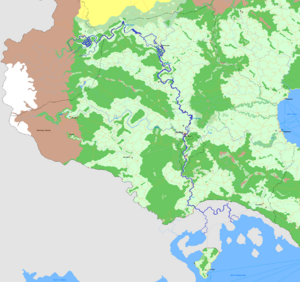1728 Khordad Floods: Difference between revisions
No edit summary |
No edit summary |
||
| Line 35: | Line 35: | ||
| casualties2 = | | casualties2 = | ||
| casualties3 = | | casualties3 = | ||
| reported deaths = | | reported deaths = 6,054 | ||
| reported injuries = | | reported injuries = | ||
| reported missing = | | reported missing = | ||
| Line 79: | Line 79: | ||
The rail link between Maulikpur, Akbarabad and Ambarganj was decommissioned. The stability of the railway bridge at Akbarabad was uncertain. Sections of track had disappeared on the Maulikpur to Akbarabad section. This rail link is part of the [[Apollonian Express]]. Other rail links were also taken out of service, such as the rail link between Ambarganj and Niravata. | The rail link between Maulikpur, Akbarabad and Ambarganj was decommissioned. The stability of the railway bridge at Akbarabad was uncertain. Sections of track had disappeared on the Maulikpur to Akbarabad section. This rail link is part of the [[Apollonian Express]]. Other rail links were also taken out of service, such as the rail link between Ambarganj and Niravata. | ||
== From emergency to reconstruction == | |||
The Çakari Armed Forces evacuated more than 110,000 people from the flood-ravaged area. The [[Apollonian Association of Refugees]] set up relief camps to house the evacuees. The [[Apollonian Security Assistance Force]] was deployed to repair the damaged infrastructure as soon as possible. Or make emergency arrangements. | |||
== See also == | == See also == | ||
Revision as of 20:28, 27 January 2024
 | |
| Date | 14.VIII.1728 AN |
|---|---|
| Location | Adardesh, Leyl, Parvatalaya and Sunehra |
| Deaths | 6,054 |
The 1728 Khordad Floods occurred when a cloudburst occurred over western princely state of Çakaristan, Sunehra, on 14.VIII.1728 AN. This caused devastating floods and landslides. The rainfall received that month was far greater than the rainfall the state usually received. Debris blocked the rivers, causing major overflow.
The flood followed the Adaraney river, so the states of Parvatalaya, Adardesh (states of Haritdesh) and Leyl also faced floods. Due to heavy rainfall, water levels in the Alba and Leyl rivers were also high. The dam at Khodapatnam was closed to prevent more water from Lake Jodha from entering the Leyl River.
Overview
The Çakari Armed Forces was deployed wholesale to provide assistance. People were evacuated throughout the river valley. Just north of Ambarganj, an emergency canal was dug to divert the water to wetlands away from the city. The same city's airport flooded and thus fell out of use. As a result, the armed forces built an emergency airfield east of the city.
In Akbarabad, the artificial river island could not be prevented from flooding. The Burj al-Saaeat al-Sultanii was protected by sandbags, which were supposed to break the water before it reached the tower.
Due to spots where the valley offers more space for the water, the speed of the water was slowed down and its force weakened. The canal town of Maulikpur was reasonably well prepared for a considerable rise in water levels. An open dam had been built in front of the town to break the water and hold back any large debris. This also prevented damage to the railway bridge.
The high water caused the Leylpur airport to be partially submerged. As a precaution, all air traffic was cancelled. In the city, outside flooded basements and flooded streets, damage was limited. This set the tone for the rest of the river course. The banks flooded, but the damage was manageable.
Apollonian Express
The rail link between Maulikpur, Akbarabad and Ambarganj was decommissioned. The stability of the railway bridge at Akbarabad was uncertain. Sections of track had disappeared on the Maulikpur to Akbarabad section. This rail link is part of the Apollonian Express. Other rail links were also taken out of service, such as the rail link between Ambarganj and Niravata.
From emergency to reconstruction
The Çakari Armed Forces evacuated more than 110,000 people from the flood-ravaged area. The Apollonian Association of Refugees set up relief camps to house the evacuees. The Apollonian Security Assistance Force was deployed to repair the damaged infrastructure as soon as possible. Or make emergency arrangements.
